Business Community Environment
Ancich Dock project hits raw nerve: Is Gig Harbor a fishing town or yacht haven?
There’s a lot to like about the plan to replace the century-old Ancich Dock, which juts 270 feet into the bay from downtown Gig Harbor’s Millville neighborhood. The owner’s plan, approved by the city, would (carefully) remove 59 piles treated with toxic creosote and make other changes to lessen the structure’s impact on underwater ecology.
The old dock at 3615 Harborview Drive is essentially condemned by the state. If it isn’t replaced, it must be removed, and Gig Harbor would lose an asset to what’s supposed to be a working waterfront.
Yet the marina project has stirred substantial opposition. At three public hearings last year, neighbors decried its potential impact on street parking. Local commercial fishermen and their allies worry the proposed new dock will impinge on waters next door that are reserved for their future homeport. They also said it upends an unwritten rule that keeps marinas and other shoreline facilities in their own lanes, ensuring they don’t encroach on each other.
Yachts vs. seiners
The dock’s future depends on the outcome of a Feb. 3 appeal before the state Shoreline Hearings Board. In the online-only proceeding, Jim Franich, a former city council member and neighbor to the project, will square off against the city, the Ancich Dock’s owner and their respective lawyers, challenging the city of Gig Harbor Hearing Examiner’s decision granting the project a Shoreline Substantial Development Permit.
The flap over the Ancich Dock stirs more than the usual old vs. new development tensions locally. It touches a nerve wrapped around the city’s very identity: Is Gig Harbor a fishing village or a collection of upscale marinas? Is its iconic vessel a purse seiner or a luxury motor yacht?
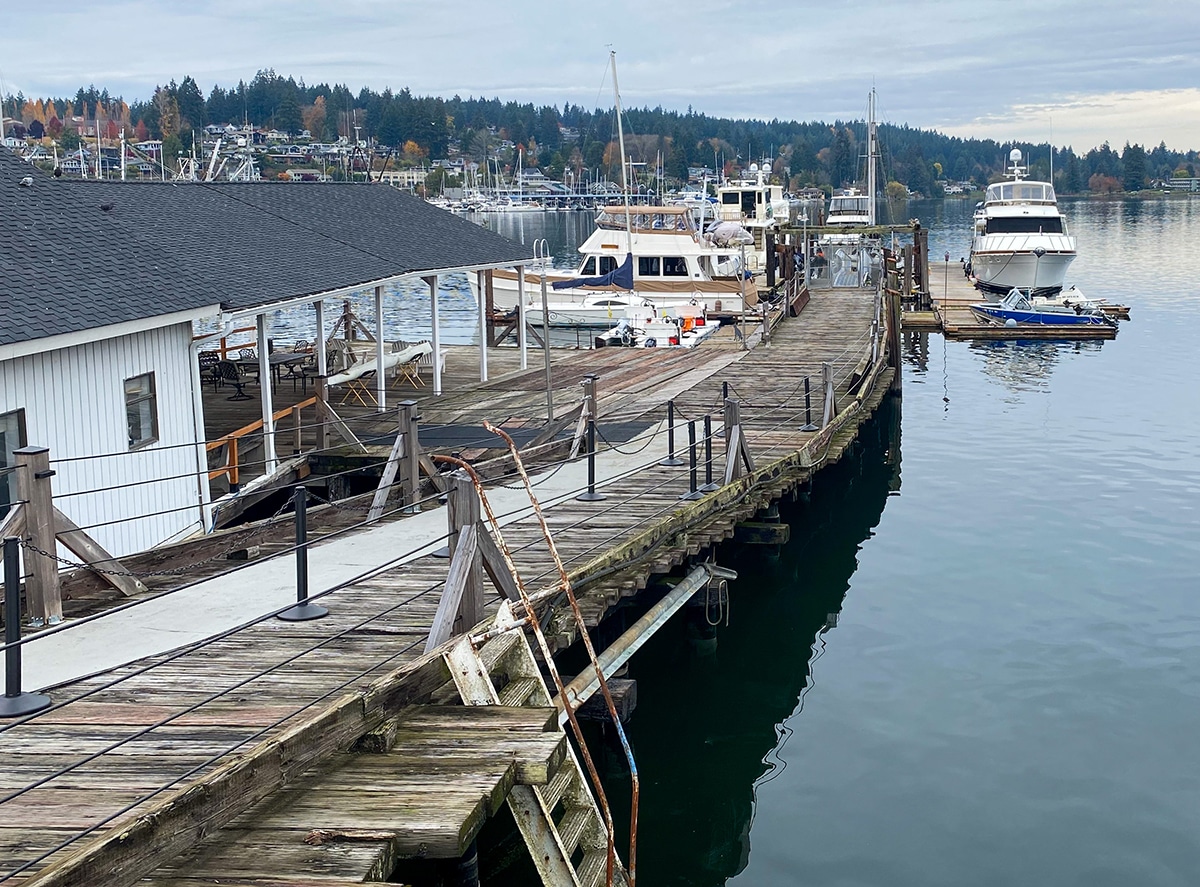
Ancich Dock. Photo by Ted Kenney
As the hearing examiner wrote in his decision, “Gig Harbor has a long and noble history of providing moorage to the regional commercial fishing fleet.”
“This project demonstrates the drifting from that heritage to one focused increasingly on pleasure craft. Not surprisingly, such change encounters opposition by those who believe that the City’s history, including its connection to commercial fishing, should be preserved and protected.”
Ancich Dock history
The Ancich Dock, or more correctly the Ancich-Tarabochia Dock, springs from that heritage. Built by Croatian immigrants, it served generations of fishermen working in salmon, sardine and other fisheries. The site includes a 1,500-square-foot netshed that is on the city’s registry of such historic structures, as well as a residence. The site was also a United States Coast Guard station in the 1970s and ’80s, and home to the cutter Point Glass.
In 2021, ownership passed from the Ancich-Tarabochia partnership to John Lee, a dentist from Beaverton, Oregon. Lee is represented in his Ancich Dock dealings by his agent, Thomas Lerch, a retired U.S. Navy officer and pilot and tech company founder who lives at the site.
Lerch said his landlord maintains a second home in Gig Harbor. Lee’s involvement with the marina began when he was out walking and saw a “For Sale” sign posted on it, Lerch said.
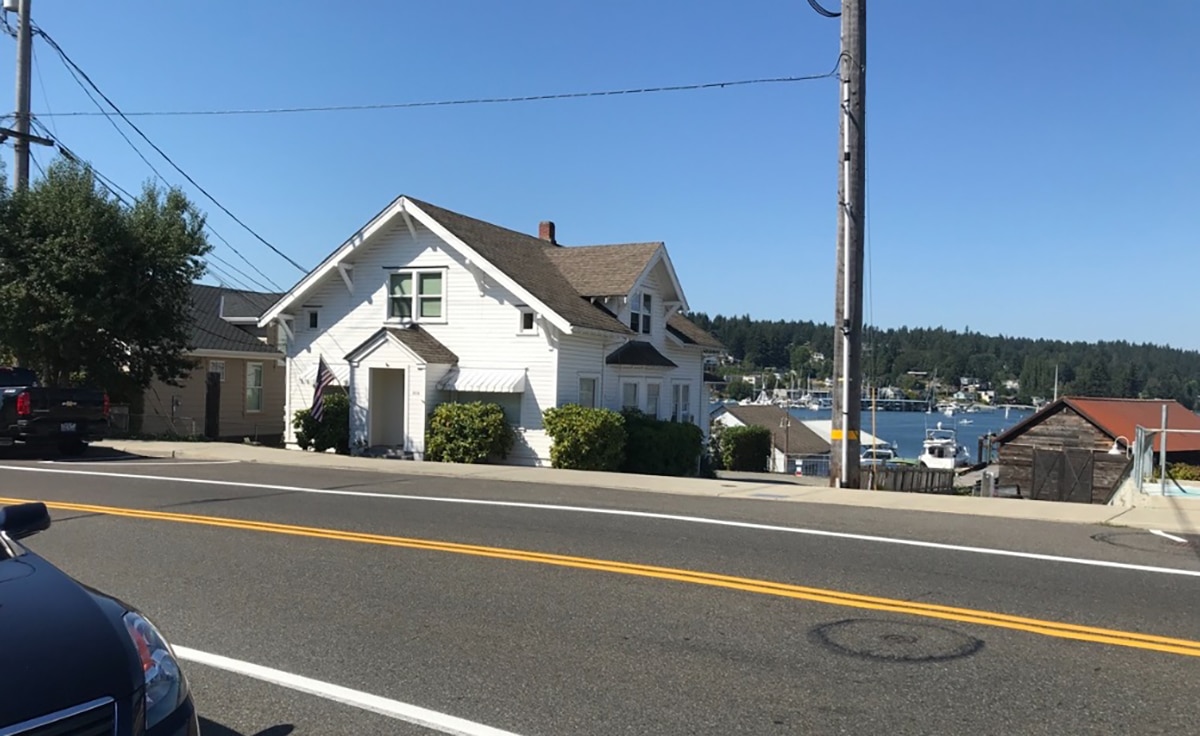
The Ancich Dock property 3615 Harborview Drive includes a single-family house fronting Harborview Drive. In the days when the United States Coast Guard used the property, this was the station chief’s home. The property also includes the dock and a 1,500 square-foot netshed. Image courtesy Pierce County Assessor-Treasurer Office
Lee bought the Ancich marina with the goal of creating something valuable for the community, Lerch said.
But after closing on the property, Lee got off on the wrong foot with some locals by asking several commercial fishing boats to vacate the site. (Lerch explained the vessels were tied up there under informal arrangements, and Lee was uncomfortable acting as landlord when the site wasn’t being run as a marina business. Local fishermen still grumble about the incident.)
At the time of its purchase, the Ancich Dock was living on borrowed time. The Washington Department of Natural Resources (DNR), which owns the tidelands beneath it, had made removing or replacing the structure a condition of renewing the tidelands lease.
New dock proposed
Outdated facilities like the Ancich Dock need to go, in the view of shoreline regulators. Creosote-treated piles leach toxins into the air and water. Solid decks and piers cast shadows that damage habitat and marine life below. Wood construction wears out, and its replacement disrupts surrounding waters and the sea floor. The galvanized steel piles and grated aluminum surfaces used in new docks last much longer.
In late 2023, Lee and Lerch submitted plans to the city for a new dock with much-improved light penetrability, steel piles and an over-water footprint about 1,600 square feet smaller than the old one. The city concluded the proposal met criteria for a permit, triggering review by the hearing examiner.
Some neighbors weren’t enamored of the proposal. The marina sits next to Ancich Park, along a curve in Harborview Drive with limited visibility. It’s a popular area with shops, a kayak paddlers’ dock and other waterfront attractions.
Parking can be tight. The city requires new marinas to provide one off-street parking space for every two moorage slips that accommodate vessels less than 45 feet long, and one parking space per moorage slip that serves longer vessels.
The marina already had seven off-street parking spaces — not enough for the new facility that was envisioned. However, the structure pre-dates the city’s parking code and shoreline rules. As a vested “existing use,” Ancich Dock is not bound by these restrictions, as long as the planned improvements don’t increase the amount of moorage it offers, city officials concluded.
“Neighbors in Millville request either more on-site parking for the New Ancich Marina or reduce the number of moorage/slips for BOATS,” wrote Linda Foster of Citizens from the Millville Neighborhood in her e-mail to the hearing examiner.
Moorage question
Proving how much moorage the old dock historically provided — a necessary task, in order to ensure the new marina did not exceed that amount — turned into an interesting side-battle in the permitting conflict. Both supporters and opponents of the project submitted dozens of aerial photos, some decades old, to show how many boats were tied up there in different years.
Lerch said the new Ancich Dock will not burden downtown parking. The proposed marina will offer slips for vessels 60 feet and longer. Larger boats tend to cruise for days or weeks at a time, and owners leave their cars at home, he said.
While parking trouble brewed on land, another dispute arose over the proposed dock’s likely impact in surrounding waters.
Gig Harbor’s commercial fishing community has high hopes for Ancich Park. The city’s Commercial Fishing Homeport has been planned at the park for more than 10 years, as the city has worked to surmount the project’s environmental and financial hurdles. The city has leased the tidelands in front of the park from DNR to accommodate the homeport.
The envisioned $3.2 million homeport would provide moorage for 17 local commercial fishing vessels. Boat owners say the facility is crucial to their future, due to Gig Harbor’s dwindling supply of affordable private docks. (Those familiar with commercial fishing say boat owners rely on moorage costing less than $10 per linear foot, while marinas charge pleasure craft upwards of $15 per linear foot.)
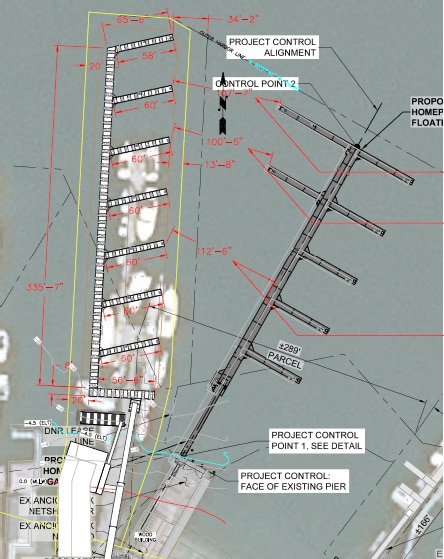
The proposed new Ancich Dock, left and the proposed new Commercial Fishing Homeport, right.
Public Trust Doctrine
The proposed new Ancich Dock would stick straight into the bay, with seven “finger piers” extending eastward from its main section, at a slight angle, toward the proposed homeport. The Ancich Dock fills most of its leased tidelands. To enter and exit, boats would need to maneuver over tidelands that are leased by the city for the homeport.
Both the city and DNR take the position that Ancich Dock tenants should be allowed to transit through the future homeport’s waters. They cite the Public Trust Doctrine, a legal principle holding that land or waterways held by the state should be available to be used for the public’s benefit.
The Ancich Dock’s reliance on homeport waters for maneuvering would not prevent the homeport from being built. But some feel the city’s argument based on the Public Trust Doctrine sets a bad precedent.
“I do not believe [the doctrine] is a development tool” to provide access for private ventures, said Guy Hoppen, owner of the 90-foot commercial vessel Beryl E. and long-time advocate for the homeport.
To the contrary, he and other fishermen point to what they believed was a longstanding rule that marinas should be constructed so that users will not transit through neighboring facilities’ waters. Hoppen, for one, said he was surprised to learn that this rule was not codified into law.
Hoppen said applying the Public Trust Doctrine in this way could lead to a “Wild West” situation in which property owners hurry to construct docks that rely on neighbors’ tidelands for access, before neighbors can do the same to them. With the doctrine interpreted this way, “wouldn’t a ‘first come, first served’ development precedent be established leading to lease chaos?” he wrote to the hearing examiner.
Priority on the tidelands
The hearing examiner’s decision, when it came down last fall, dissatisfied many.
It endorsed the argument, based on the Public Trust Doctrine, that boats using the new Ancich Dock can maneuver in the proposed homeport’s city-leased waters. But it held such use to be “secondary and inferior” to use of these tidelands by the city and the homeport.
“In the event of any conflict between the primary use by the tidelands’ lessees and vessels moored at this marina, use by the tidelands’ lessees is primary and, if necessary, can require the restriction of any use by vessels from this marina should such restriction be reasonably necessary to assure the full intended use by the tidelands’ lessee,” the decision stated.
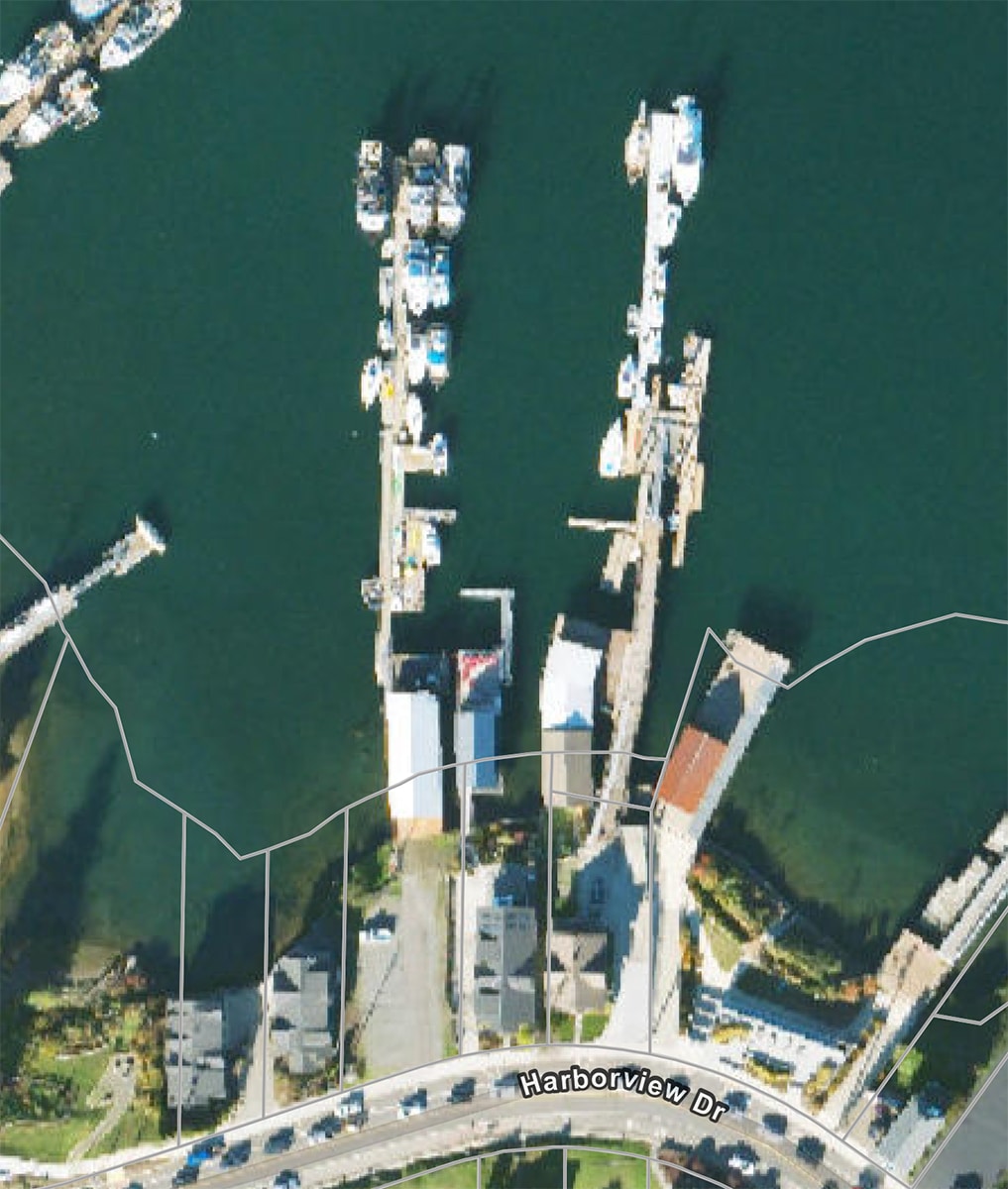
Aerial photo shows the existing Ancich Dock, on the right of the two marinas; and Ancich Park, where a new Commercial Fishing Homeport is planned. Courtesy of the city of Gig Harbor
Lerch said that while he and the Ancich Dock’s owner could object to the decision assigning a lower priority to their use of the waters than the city’s and the homeport’s use, they “don’t believe it’s particularly enforceable.”
On this point, Lerch and Hoppen agree. The hearing examiner may declare the homeport’s rights to leased tidelands are superior to the Ancich Dock’s, but “well, OK, but you mean the city’s going to come after a multi-million dollar project next door and tell them to move it?” Hoppen asked rhetorically.
In response to Hoppen’s concern that this interpretation of the Public Trust Doctrine could lead to a Wild West situation of shoreline property owners infringing on neighbors’ tidelands, the hearing examiner stated he recognized the “legitimacy” of that argument.
However, he concluded, the resolution of this issue “is outside the scope of my authority. The answer to this dilemma, if there is one, is to be found through enhanced City regulation which only the City Council has the power to enact.”
Parking cars and parking boats
On the contentious question of parking, the hearing examiner concurred with the city that the new Ancich Dock is exempt from off-street parking requirements, as long as it does not increase the amount of moorage it has provided historically.
The new dock can provide moorage for up to 17 vessels without offering any additional on-site parking, the hearing examiner ruled. And to ensure the marina and its users respect this limitation, he mandated that all 17 berths must be identified on a city-approved site plan setting forth each berth’s number, location and length, along with other restrictions.
Many in Gig Harbor’s commercial fishing community reject the idea that the new Ancich Dock is a continuation of its historic use at all, since the old facility primarily served commercial vessels while the new one targets pleasure craft. This will be a key point in Jim Franich’s upcoming appeal, which argues the redeveloped Ancich Dock should be required to provide the same amount of off-street parking as a new marina.
“This project will completely demolish an existing Commercial Fishing Facility and construct a new Recreational Marina with expanded use and insufficient on-site parking,” Franich’s petition to the Shoreline Hearings Board states.
Or as Guy Hoppen puts it, the Ancich Dock property was “was not a marina” in the past but instead was a “commercial fishing family property.”
‘A maritime town’
For his part, Lerch said he rejects drawing a hard line between commercial and recreational uses in defining what kind of development Gig Harbor should foster — and that support for both kinds of development is emphasized in the city’s Shoreline Master Program.
“I reject the contention that Gig Harbor is a fishing town. It’s a maritime town,” he said.
The new Ancich Dock will have 14 slips that can accommodate craft up to 60 feet, as well as a long float that will be divided into slips for vessels that are 70 feet and longer. Monthly rent will be based on the size of the slip, not on the size of the boat – so a 40-footer would still have to pay for 60 feet of moorage, Lerch said.
“I’m glad to rent to anybody who wants to talk to us,” including commercial vessels, he said.
The Ancich Dock and its ongoing marina project have been listed for sale since late last year, with an asking price of $6 million. Lerch acknowledged that the owner is “testing the waters” with this listing but said the property has not sold, and “Mr. Lee is committed to building the dock.”
Considering that the project is in the heart of Gig Harbor and has a historic netshed, there are no other planned marinas on the horizon in Gig Harbor that are as significant, Lerch said. “We believe that this is the most important maritime development in Gig Harbor this decade.”
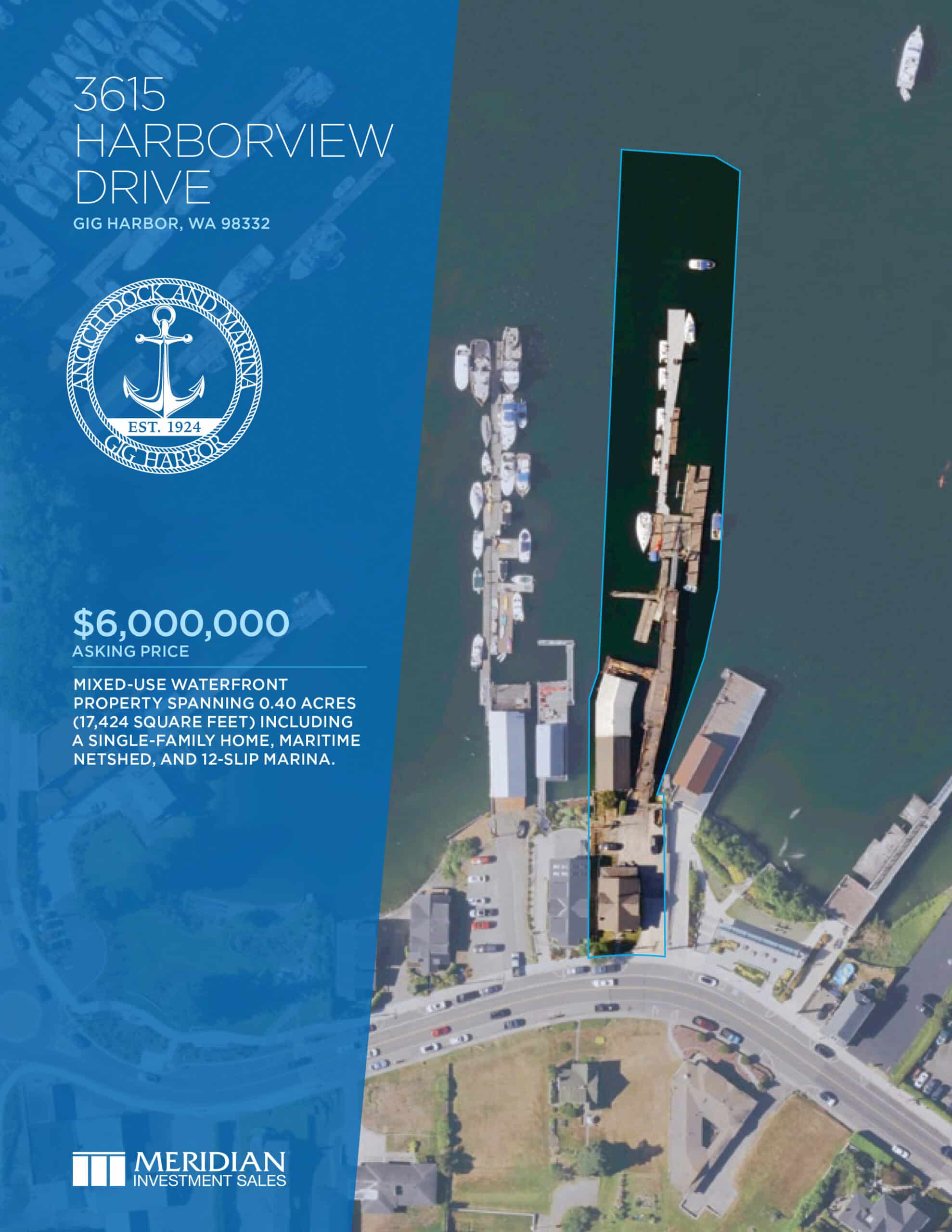
Marketing material for the Ancich Dock and Marina, for sale for $6 million. A representative of the owner termed the listing as “testing the waters.”

